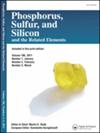Synthesis and application of Fe3O4@RHA nanocatalyst in the synthesis of polyhydroquinolines and dihydropyrimidinones (statistical approach to optimize parameters)
IF 1.4
4区 化学
Q4 CHEMISTRY, INORGANIC & NUCLEAR
Phosphorus, Sulfur, and Silicon and the Related Elements
Pub Date : 2024-09-02
DOI:10.1080/10426507.2024.2421880
引用次数: 0
Abstract
In this study, rice husk ash as silica source was obtained and then, by adding Fe3O4, Fe3O4@RHA core-shell nanocatalyst was prepared. The Fe3O4@RHA nanocatalyst was identified using VSM, XRD, FE-SEM, EDX, and FT-IR analysis, and the optimization of the effective parameters in the reaction was done using response surface methodology (RSM). This nanocatalyst had spherical particles with an average particle size of about 30 nm and good magnetic properties of about 42 emu/gr. The Fe3O4 particles encapsulated in RHA were easily recovered and showed good catalytic activity. Using Fe3O4@RHA biosynthesized nanocatalyst, polyhydroquinoline derivatives were obtained through multi-component condensation of ammonium acetate, aldehyde, ethyl acetoacetate, and dimedone, under solvent-free conditions at 80 °C, as well as dihydropyrimidinone derivatives through multi-component reactions by condensation of urea, aromatic aldehyde, and β-Keto ester under solvent-free conditions at 70 °C. Fe3O4@RHA nanocatalyst was introduced as a heterogeneous, stable, and environmentally compatible catalyst; in its production, dangerous materials, reagents, and solvents were avoided and it is environmentally friendly. In addition, it has the advantage of being recyclable, resulting in short reaction time, high product yield, and economically good performance.
Fe3O4@RHA纳米催化剂在聚对苯二酚和二氢嘧啶合成中的合成及应用(统计方法优化参数)
本研究以稻壳灰为硅源,加入Fe3O4,制备Fe3O4@RHA核壳纳米催化剂。采用VSM、XRD、FE-SEM、EDX、FT-IR等方法对Fe3O4@RHA纳米催化剂进行了表征,并利用响应面法(response surface methodology, RSM)对反应的有效参数进行了优化。该纳米催化剂具有平均粒径约为30 nm的球形颗粒和良好的磁性能,约为42 emu/gr。包封在RHA中的Fe3O4颗粒易于回收,并表现出良好的催化活性。利用Fe3O4@RHA生物合成纳米催化剂,在80℃无溶剂条件下,通过乙酸铵、醛、乙酰乙酸乙酯和二美酮的多组分缩合得到聚对苯二酚啉衍生物,在70℃无溶剂条件下,通过尿素、芳醛和β-酮酯的多组分缩合反应得到二氢嘧啶衍生物。Fe3O4@RHA纳米催化剂是一种多相、稳定、环境相容的催化剂;在生产过程中,避免了危险物质、试剂和溶剂,具有环保性。此外,它还具有可循环利用的优点,反应时间短,产品收率高,经济性能好。
本文章由计算机程序翻译,如有差异,请以英文原文为准。
求助全文
约1分钟内获得全文
求助全文
来源期刊
CiteScore
2.60
自引率
7.70%
发文量
103
审稿时长
2.1 months
期刊介绍:
Phosphorus, Sulfur, and Silicon and the Related Elements is a monthly publication intended to disseminate current trends and novel methods to those working in the broad and interdisciplinary field of heteroatom chemistry.

 求助内容:
求助内容: 应助结果提醒方式:
应助结果提醒方式:


